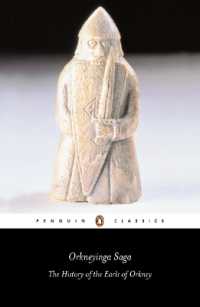- ホーム
- > 洋書
- > 英文書
- > Juvenile Grades 7-9
Full Description
Build solid mathematical understanding and develop key conceptual connections. The inquiry-based approach integrates the MYP key concepts, helping you shift to a concept-based classroom and cement mathematical comprehension. Fully comprehensive and matched to the Revised MYP to support achievement.
Progress your learners into IB Diploma - fully comprehensive and matched to the MYP Next Chapter curriculum
Develop conceptual understanding in the best way for your learners - learn by mathematical unit or by key concept
Drive active, critical exploration of mathematical principles - build rounded comprehension framed within the key and related concepts
Develop meaningful cross-curricular connections that help learners recognize and manipulate mathematical ideas in other disciplines
Support higher level thinking skills through an approach grounded in factual, conceptual and debatable questions
Build a solid foundation of practical skills with extensive practice equipping learners to apply skills
Fully prepare learners for the MYP eAssessment
This pack includes one print Student Book and one online Student Book. The online Student Book will be available on Oxford Education Bookshelf until 2028. Access is facilitated via a unique code, which is sent in the mail. The code must be linked to an email address, creating a user account. Access may be transferred once to an additional user.
Contents
Unit 1 Numbers and number systems: Civilizations and human interactions
1.1: Representing numbers
1.2: Place value, expanded form and scientific notation
1.3: Number systems with different bases
1.4: Powers, indices and roots
1.5: Factors, multiples and prime numbers
1.6: Greatest common factor and lowest common multiple
1.7: Factors and divisibility
1.8: Order of operations
1.9: Number systems from different civilizations
Unit 2 Percentages: Inequality and difference
2.1: Different forms of percentages
2.2: Converting fractions and percentages
2.3: Converting decimals and percentages
2.4: Applications of percentages
2.5: Percentage increase and decrease
Unit 3 Algebraic expressions and equations: Patterns in nature
3.1: Patterns in different forms - diagrams, sequences, tables and words
3.2: Simplifying algebraic expressions
3.3: Generalizing mathematical patterns
3.4: Patterns as functions
3.5: Algebraic equations
3.6: Patterns in nature
Unit 4 Geometric constructions: Artistry and creativity
4.1: Rays, line segments and lines
4.2: Classifying, measuring and constructing angles
4.3: Angles formed by intersecting lines and parallel lines with a transversal
4.4: Classification of triangles
4.5: Interior and exterior angles of triangles
Unit 5 Fractions: Human connections
5.1: Fractions in different forms
5.2: Comparing fractions
5.3: Multiplying and dividing fractions
5.4: Adding and subtracting fractions
5.5: Multiple operations with fractions
Unit 6 Data management: Trends in communities
6.1: Types of data
6.2: Representation of data
6.3: Types of graphs
6.4: Comparison of data and showing trends
6.5: Misleading graphs
Unit 7 Perimeter, area and volume: Environmental impacts
7.1: Venn diagrams
7.2: Perimeter and area of triangles, rectangles and compound shapes
7.3: 2D shapes and the volume of corresponding prisms
7.4: Volume of rectangular and triangular prisms
7.5: Surface area of rectangular and triangular prisms
7.6: Relationships between surface area and volume of prisms






